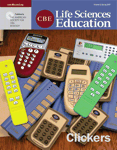What Good Is a Scientist in the Classroom? Participant Outcomes and Program Design Features for a Short-Duration Science Outreach Intervention in K–12 Classrooms
Abstract
Many short-duration science outreach interventions have important societal goals of raising science literacy and increasing the size and diversity of the science workforce. Yet, these long-term outcomes are inherently challenging to evaluate. We present findings from a qualitative research study of an inquiry-based, life science outreach program to K–12 classrooms that is typical in design and excellent in execution. By considering this program as a best case of a common outreach model, the “scientist in the classroom,” the study examines what benefits may be realized for each participant group and how they are achieved. We find that K–12 students are engaged in authentic, hands-on activities that generate interest in science and new views of science and scientists. Teachers learn new science content and new ways to teach it, and value collegial support of their professional work. Graduate student scientists, who are the program presenters, gain teaching and other skills, greater understanding of education and diversity issues, confidence and intrinsic satisfaction, and career benefits. A few negative outcomes also are described. Program elements that lead to these benefits are identified both from the research findings and from insights of the program developer on program design and implementation choices.



